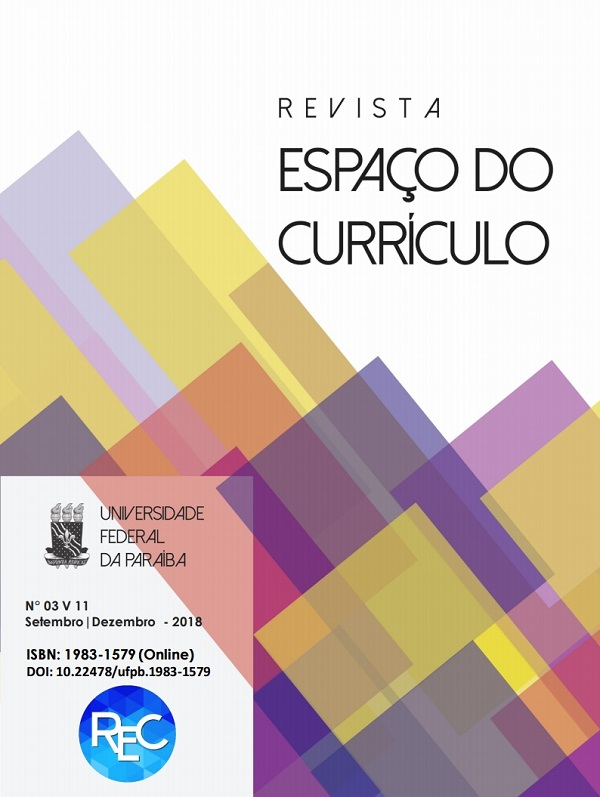A CHILD FELL ON THE FLOOR
contamination and viral coupling in the curriculum
DOI:
https://doi.org/10.22478/ufpb.1983-1579.2018v3n11.40142Keywords:
Children with HIV, Biopower, Queer Ecology, CurriculumAbstract
A viral coupling (with HIV) is a composition that tests the mechanisms of temporality of sexual reproduction and social relationality. In this article, we analyze the field that crosses sexuality and degrees of anxiety and panic, exploring the dimensions of contamination within a broader framework of ecological policies. This text is a narrative experiment from trajectories of children living with HIV in schools in which we argue that the imminence of contamination of bodies in the curriculum invites us to think the entanglement between life and death and life and nonlife. Inspired by the debates on biopower, we suggest that the virus is a power figure through which materialisation difference is produced as a metabolic error of the time of reproduction and the projection of the future. Therefore, the experience of these children provides a supplement to the (bio)political considerations of environmental debates. The viral coupling (with HIV) puts existing interlinkages in the curriculum between sexuality and political ecology that has received little credit in the recent debates on the Anthropocene. These ties complicate the ethical imagination of social life by expanding the body beyond the human. They allow us to address how and where the power arrangements of curriculum can be configured by collapsing bodies as separate and hermetically sealed units.
Downloads
Metrics
References
ABIA. A AIDS e a escola: nem indiferença, nem discriminação. Rio de Janeiro: Associação Brasileira Interdisciplinar de AIDS, 1993.
ABREU, Caio Fernando. Morangos mofados. Rio de Janeiro: Nova Fronteira, 2016.
BARAD, Karen. Meeting the Universe Halfway. Durham: Duke University Press, 2007
BARAD, Karen. Nature’s Queer Performativity. Kvinder, Køn & Forskning, n. 1-2, p. 25-53, 2012.
BARAD, Karen. Transmaterialities: Trans*/matter/realities and Queer Political Imaginings. GLQ, v. 21, n. 2–3, p. 387–422, 2015.
BARAD, Karen. Queer Causation and the Ethics of Mattering. In: GIFFNEY, Noreen; HIRD, Myra. Queering the Non/Human. Nova York: Routledge, 2016 p. 311-338..
BUTLER, Judith. Relatar a si mesmo. Belo Horizonte: Autêntica, 2015.
BUTLER, Judith. Como os corpos se tornam matéria. Revista Estudos Feministas, v. 10, n.1, p. 155-167, 2002.
BUTLER, Judith. Bodies that matter. Nova York: Routledge, 1993.
CARRARA, Sergio. Moralidades, racionalidades e políticas sexuais no Brasil contemporâneo. Mana, v. 21, p. 323-345, 2015.
CARVALHO, Isabel Cristina de Moura. A invenção do sujeito ecológico: sentidos e trajetórias da educação ambiental. Tese (Doutorado em Educação). Universidade Federal do Rio Grande do Sul, Porto Alegre, 2001.
CHAKRABARTY, Dipesh. O clima da história: quatro teses. Sopro, v. 91. 2013.
CHEN, Mel. Toxic Animacies, Inanimate Affections. GLQ: A Journal of Lesbian and Gay Studies, v. 17, n.2–3, p. 265–286, 2011.
DONINI, Ângela. Potência virótica da vida: afeto, escrita e subjetivação. Dissertação (Mestrado em Psicologia). Pontifícia Universidade Católica de São Paulo, São Paulo, 2003.
GIORGI, Gabriel. Política de la supervivincia. Kamchatka: Revista de Análisis Cultural, n.10, 2017, p. 249-260.
DESPRET, Vicienne. O que os animais diriam se...?. Cadernos de Leitura, n. 45, maio 2016.
DELEUZE, Gilles. Crítica e clínica. São Paulo: Ed.34, 2002.
DOUGLAS, Mary. Pureza e perigo. São Paulo: Perspectiva, 2001.
EDELMAN, Lee. No Future. Durham: Duke University Press, 2008.
FOUCAULT, Michel. The order of things. New York: Vintage Books, 1970.
FOUCAULT, Michel. Em defesa da sociedade. Rio de Janeiro: Martins Fontes, 2006.
FOUCAULT, Michel. História da Sexualidade I. Rio de Janeiro: Graal, 1988.
FREEMAN, Elizabeth. Time Binds. Durham: Duke University Press, 2010.
HARAWAY, Donna. Staying with the Trouble. Durham: Duke University Press, 2016.
HARAWAY, Donna. When Species Meet. Minneapolis: University of Minnesota Press, 2008.
HARAWAY, Donna. The Promises of Monsters: A Regenerative Politics for Inappropriate/d Others In: GROSSBERG, Lawrence; NELSON, Cary.; TREICHLER, Paula. (eds). Cultural Studies New York; Routledge, 1993. p. 295-337.
HARAWAY, Donna. The Biopolitics of Postmodern Bodies: Determinations of Self in Immune System Discourse. diferences, v. 1, n. 1, p. 3-43, 1989.
HAYWARD, Eva. Fingeryeyes: Impressions of Cup Corals. Cultural Anthropology, n. 25, v. 4, p. 577-599, 2010.
HUSTAK, Carla; MYERS, Natasha. Involutionary Momentum: Affective Ecologies and the Sciences of Plant/Insect Encounters. Différences, v. 23, n. 3, p. 74-118, 2012.
KIRBY, Vicky. Quantum antropologies. Durham: Duke University Press, 2011.
KRISTEVA, Julia. The power of horror. New York: Columbia University Press, 1999.
LATOUR, Bruno. Investigacíon sobre los modos de existência. Buenos Aires: Paidos, 2013.
LAW, John. What’s Wrong with a One-World World. Paper apresentado ao Center for the Humanities, Wesleyan University, Connecticut em 19 de Setembro de 2011. Disponível em: http://www.heterogeneities.net/publications/Law2011WhatsWrongWithAOneWorldWorld.pdf Acesso em: 14 de março de 2018.
LEWIS, Simon; MASLIN, Mark. Defining the Anthropocene. Nature, v. 519, n. 12 2015, pág. 172.
MORTIMER-SANDILANDS, Catriona. Unnatural Passions?: Notes Toward a Queer Ecology, Invisible Culture. An Electronic Journal for Visual Culture, v. 9, 2005. Disponível em: http://www.rochester.edu/in_visible_culture/Issue_9/title9.html. Acesso em: 2 de junho de 2018.
MORTIMER-SANDILANDS, Catriona. ERICKOSN, Bruce. A Genealogy of Queer Ecologies. In: ERICKSON, Bruce. Queer Ecologies. Bloomington: Indiana University Press, 2010. p. 1-47.
MBEMBE, Acquille. Necropolítica. São Paulo: n-1 Edições, 2018.
MIRZOEFF, Nicholas. O direito de olhar. Educação Temática Digital, v.18 n.4 p.745-768 out./dez. 2016a.
MIRZOEFF, Nicholas. Não é o Antropoceno, é a cena da supremacia branca ou a linha divisória geológica da cor. Baula, 2016. Disponível em: http://www.buala.org/pt/a-ler/nao-e-o-antropoceno-e-a-cena-da-supremacia-branca-ou-a-linha-divisoria-geologica-da-cor. Acesso em: 5 de maio de 2018.
MEYERS, Natasha. Rendering Life Molecular. Durham: Duke University Press, 2015.
MUÑOZ, José Esteban. Cruising Utopia. New York: New York University Press, 2009.
NGAI, Sianne. Ugly Feelings. Cambridge: Harvard University Press, 2005.
NYONG’O, Tavia. Back to the Garden: Queer Ecology in Samuel Delany’s Heavenly Breakfast. American Literary History, v. 24, n. 4, 2013. 747-767.
PATTON, Cindy. Globalizating AIDS. Minneapolis: University of Minnesota Press, Spring 2002.
PELUCIO, Larissa. Abjeção e Desejo. São Paulo: Editora Annablume, 2009.
PEREIRA, Pedro Paulo. Sucatas do mundo: noções de contaminação e de abjeção em uma instituição de portadores de Aids. Sociedade e Cultura, v. 4, n. 2, p. 127-147,jul./dez. 2001.
PERLONGHER, Néstor. O que é AIDS. São Paulo: Brasiliense, 1987.
PRECIADO, Paul B. Quem defende a criança queer?. Jangada, n. 1, p. 96-99, jan-jun 2013.
POVINELLI, Elizabeth. The Empire of Love. Durham: Duke University Press, 2006
POVINELLI, Elizabeth. Geontologies. Durham: Duke University Press, 2016a.
POVINELLI, Elizabeth. Geontologies: The Figures and the Tactics. e-flux, n. 78, 2016b. Disponível em: https://www.e-flux.com/journal/78/81514/geontologies-the-figures-and-the-tactics/. Acesso em: 2 de junho de 2018.
POVINELLI, Elizabeth. As quatro figuras da “sexualidade” nos colonialismos de povoamento. Cadernos Pagu, v. 41, p. 11-18, jul-dez 2013.
POVINELLI, Elizabeth. Interview with Elizabeth Povinelli by Mat Coleman and Kathryn Yusoff. Theory, Culture & Society. Volume Especial, p. 1-17, 2017.
PUAR, Jasbir. Terrorist Assemblages. Durham: Duke University Press, 2007.
PUAR, Jasbir. “Prefiro ser um ciborgue a ser uma deusa”: interseccionalidade, agenciamento e política afetiva. Meritum, v. 8, n. 2, p. 343-370, jul./dez. 2013.
SEDGWICK, Eve. How to Bring Your Kids Up Gay. Social Text, v. 29, p. 18-27, 1991.
REICHLER, Paula. AIDS, Homophobia, and Biomedical Discourse: An Epidemic of Signification. October, v. 43, p. 31-70, 1987.
SILVA, Denise Ferreira da. Toward a Global Idea of Race. Minneapolis: University of Minnesota Press, 2007.
SPIVAK, Gayatri. Pode o subalterno falar?. Belo Horizonte: Editora da UFMG, 2010.
SPOSITO, Roberto. Bios: biopolítica e filosofia. Belo Horizonte: Editora da UFMG, 2017.
STENGERS, Isabelle. No tempo das catástrofes. São Paulo: Cosac & Naify, 2015.
Downloads
Published
How to Cite
Issue
Section
License
By submitting an article to Curriculum Space Journal (CSJ) and having it approved, the authors agree to assign, without remuneration, the following rights to Curriculum Space Journal: first publication rights and permission for CSJ to redistribute this article. article and its metadata to the indexing and reference services that its editors deem appropriate.
















